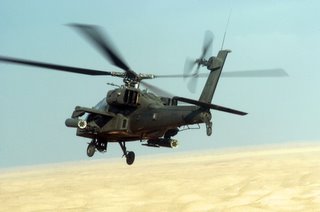The Heroes Beside Me

The following is a newspaper article written about my Brigade, that I just found (thanks Google!). For those who wonder what we are going to do after the "Greatest Generation" is gone...they are still here brother...and it's my pleasure to serve along side of them every day.
Helicopters must dodge death to complete missions (good Lord could you be more melodramatic?)
By KEN DILANIAN
Knight Ridder Newspapers
TAJI, Iraq - The Black Hawk helicopter flew low and fast over the bright lights north of Baghdad, then suddenly the lights were gone. In the darkened cockpit, the two pilots could make out an expanse of date palms through their night-vision goggles.
"Two-point-five kilometers to LZ. Tell him to start the buzz saw," said 28-year-old Capt. Jeremy Loeb, of Hamburg, Pa.
In a clearing 50 feet below, an infantry soldier began twirling a chemical light - mimicking a glowing circular saw - to signal his unit's position to the helicopter.
Within seconds, the 10-ton airship hit the ground with a dull thud. Twelve soldiers who'd been huddling in the darkness sprinted toward it and climbed in one by one. Three minutes later, the Black Hawk took off with an enormous whoosh of dust and soared away, engines whining, giant rotors slapping the air. One of the soldiers, having walked and slept on the cold ground for two days in a hunt for insurgents, let out a whoop of joy.
"This is what it's all about - picking up cold, tired soldiers and bringing them back for hot chow and a shower," said the second pilot, Warrant Officer Josh Muehlendorf, 29, of Houston.
The Black Hawk's four-person crew from the 1st Cavalry Division had just completed a nighttime extraction, a routine mission in one of the unheralded corners of the Iraq war. Attack and transport helicopters are being used in Iraq with greater frequency and intensity than at any time since Vietnam.
Over the last nine months in Iraq, 1st Cavalry aviators have had to adapt their tactics to a guerrilla war in urban areas with no front lines. Their predecessor unit saw almost no combat, but as the insurgency spread in 2004 the Cav fought hundreds of air-to-ground gun battles. It's flown more hours in the last nine months than it would in four or five years during peacetime.
It's killed hundreds if not thousands of insurgents, and an unknown number of civilians.
The 54-foot-long Black Hawks, armed with manned machine guns on each door, are used to taxi troops, supplies, civilians and VIPs, and to quickly insert or remove soldiers for raids or assaults. The smaller, nimbler Apache Longbows and Kiowa Warriors, bristling with high-tech rockets and cannons, are in the air 24 hours a day to protect and sometimes rescue ground troops.
Medevac helicopters have evacuated thousands of Americans and Iraqis alike, saving countless lives. The soldiers of the aviation unit at this sprawling base a few miles north of Baghdad love to tell little-publicized tales of medal-winning valor - "real hero stuff," in the words of Col. James McConville, the Quincy, Mass., native who commands 1st Cav's 4th Brigade, the aviation unit:
_In October, one pilot of a two-seat Apache, Capt. Ryan Welch, 30, of Lebanon, N.H., landed to retrieve two downed comrades, then strapped himself to the outside of the aircraft so that a wounded man could fly inside - a move so dangerous it's almost never done.
_In April, two pilots used hand signals to stop an Iraqi train that was about to hit a huge bomb planted on the tracks - one flying sideways so the engineer could see his face.
_That same month, two others, both shot in the arm, steered a hard landing with their knees and evaded capture.
_Two aviators, Chief Warrant Officers Wesley "Chuck" Fortenberry of Texas and Shane Colton of Oklahoma, died April 11, 2004 after their Apache was hit by a missile while they were fighting to protect a Humvee patrol and a fuel-transport convoy that were under attack, and outnumbered, on the highway. Fathers of young children, the two were awarded the Distinguished Flying Cross, one of the nation's highest military honors.
Outside the Kurdish regions in the north, Iraq is so menacing that pilots will risk their lives rather than leave a comrade on the ground for even a few minutes to await a pickup by infantry soldiers. While they sometimes drop soccer balls to children, the pilots never leave their fortified compound on the ground, and have almost no contact with regular Iraqis. Insurgent violence has erected a wall of mistrust between the Iraqi people and the American military.
Helicopters fly in pairs, as low and as fast as possible, using no lights at night. Pilots have learned not to hover for even a few seconds, to avoid giving insurgents a target. Those tactics were a marked change for Apaches, which were built to hover high above the earth in large formations behind advancing ground forces and launch Hellfire missiles at enemy tanks, as they did in the Persian Gulf War. During the March 2003 Iraqi invasion, the old methods led to an Apache being shot down and two pilots captured.
The Army learned that "If you're going to get into an urban fight with a small fleeing enemy, you've got to be moving," said Lt. Col. Ronald Lewis, who commands the 1st Cav's Apache battalion and has flown hundreds of combat hours.
That lesson was reinforced during the first six months of the occupation, when insurgents with shoulder-fired missiles shot down two helicopters, including a Chinook transport, killing 16 U.S. troops. From then on, helicopters no longer flew high, where they could be seen from farther away.
There are still no guarantees. A medevac Black Hawk crashed while avoiding ground fire last January, killing all nine soldiers aboard. Welch's heroism came after two Kiowas collided in midair for unknown reasons, killing two men.
In combat, the attack helicopters have turned the tide in any number of battles over the last year, from Najaf to Fallujah to Baghdad's Sadr City slum. They've conducted dozens of surgical strikes against insurgents who were observed planting bombs or setting up mortars. One snippet of aerial video shows an Iraqi man in a white car, filmed earlier launching mortar rounds, mowed down by rocket fire. Then it shows U.S. soldiers pulling artillery rounds out of the trunk of the car.
It wasn't supposed to be like this. When the 1st Cav's pilots arrived last March to take over greater Baghdad from the 1st Armored Division, "They told us that pretty much the shooting war was over," said Chief Warrant Officer Steve Wells, 38, of Lampasas, Texas, a Kiowa flier who's credited with saving the lives of two other pilots when they were shot down in Sadr City last April.
There'd been fewer than 10 combat helicopter engagements in the first year of U.S. occupation.
"From the time we walked in, starting in April, the place just exploded on us," Wells said.
Apaches, which have more combat power than several Abrams tanks, played a key role in the second battle of Najaf last August and the invasion of Fallujah in November.
It isn't always just insurgents who die, however. In August, a barrage from a Kiowa helicopter in Sadr City appeared to have killed several civilians, including a young girl and a television cameraman who was filming near a burning Bradley fighting vehicle. Amid denunciations of U.S. tactics, commanders issued a rare public apology for the civilian deaths but said the pilots were justified in defending themselves and destroying sensitive equipment.
"It's unfortunate but sometimes civilians do get killed," Welch said. "We do everything we possibly can to avoid that. And there's been lots of occasions when our guys maybe could engage an enemy target, but there was just unacceptable collateral damage."
Labels: Iraq














<< Home